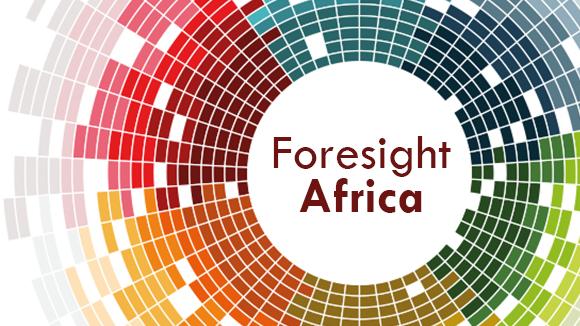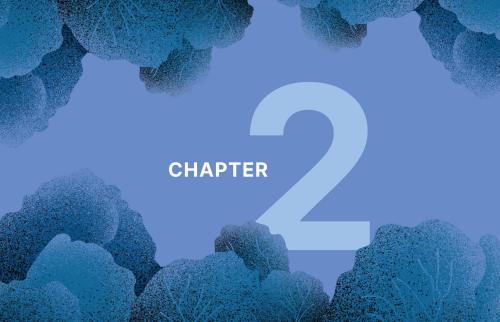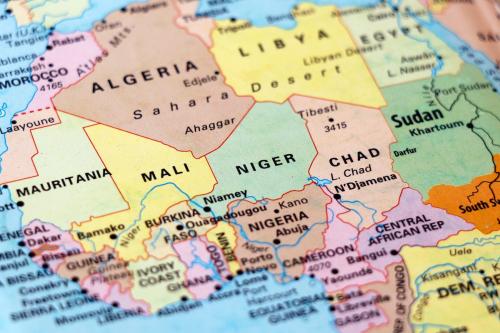This viewpoint is part of Foresight Africa 2024.
The African Sahel, which is considered a “climate hotspot,” experiences unparalleled rises in temperature, high precipitations variability, and more intense and frequent weather extreme events than the rest of the world.12 Between the 1961-1990 and 1991-2022 subperiods, the level of warming in the Sahel has increased by 0.1°C, from +0.2 °C to 0.3 °C, which is above the global average increase. In addition, it is estimated that about 110 million Africans were directly affected by climate change in 2022, out of which, there were more than 5,000 fatalities (48% caused by drought and 43% caused by flooding).3 During the monsoon season, Sahelian countries experience extreme flooding. Unsurprisingly, these events and trends have many adverse consequences on levels of growth, poverty, and food security, which are all predicted to further deteriorate in the near and longer term.
According to several estimates, the African Sahel includes countries in the world where food insecurity is the most severe. For more than 10 years, acute food insecurity has been reaching its highest level in Africa. In 2023, about 45,000 people suffered catastrophic levels of hunger in the Sahel, including 42,000 in Burkina Faso and 2,500 in Mali.4 Projected annual food imports by African countries are expected to increase by a factor of three, from US $35 billion to US $110 billion by 2025. This general trend is confirmed by the Global Food Security Index, where Sahelian countries are lagging behind in the ranking: Burkina Faso is 89th, Niger 97th, Chad 103rd, and Nigeria 107th out of 113 countries included in the ranking.
Considering the many diverse and often intertwined causes of food insecurity, it would not be true to consider climate change as the only driving factor. Clearly other factors, including high population growth, structurally weak production systems, price distortions, the recent COVID-19 pandemic, and geopolitical turmoil such as the Russia-Ukraine war, all played a role in recent food crises. Notwithstanding, the leading role climate change has played in the longer term is supported by a growing body of evidence, including Bello et al. in Nigeria, Masipa in South Africa, and Kabubo-Mariara and Kabara in Kenya.567
The channels through which climate change affects food security are numerous. First and foremost, climate change accelerates land degradation, mainly through wind and water erosion and droughts.8 Agricultural yields, food quality, and availability are all negatively affected by climate change.9 In fragile and conflict-affected countries—like most countries in the Sahel—food security is further jeopardized by infrastructure destruction and important climate-induced displacements of large communities.10 Sea-level rise and water salinization in coastal zones are also critical factors.
Adaptive policies are key to mitigating the adverse effects of climate change.
Recommendations
Adaptive policies are key to mitigating the adverse effects of climate change. These include a wide array of practices, investments, innovations, and policies intended to build resilience to climate change. Food production systems can be strengthened in the agriculture, livestock, and fishing sectors through better output pricing, the use of improved inputs, a greater mechanization of production processes, and diversification of crops and activities. Innovation can mainstream climate-smart agriculture and improve coping strategy.11 Well-targeted investments in such strategic areas as irrigation, and also building of dikes in coastal zones, are found to have a great impact on agriculture, and in mitigating the effect of sea-level rise.12 Crop supplementation is another promising avenue to fight malnutrition and insecurity without further intensifying the use of scarce inputs such as arable land, fertilizers, fresh water, and the like.13 In addition, an improvement in government information systems can provide communities exposed to climate change with early warnings about climate extreme and allow them to plan for and adapt to them accordingly.14 Weather index insurance is also an increasingly recognized tool to mitigate climate risk.15 Lastly, a better use of indigenous knowledge is found to be very effective in predicting and adapting to climate variance in rural areas.16
Adaptive strategies to climate change are numerous and diverse. An important challenge for their implementation is an accessible financial scheme for rural, and usually poor communities. The recent COP 28 set-up adaptation fund, if adequately sourced, could play a central role in bridging adaptation financial gaps for Africa’s vulnerable communities.
-
Footnotes
- Omotoso, Abeeb Babatunde, et al. 2023. “Climate change and variability in sub-Saharan Africa: A systematic review of trends and impacts on agriculture.” Journal of Cleaner Production.
- Maino, M. R., & Emrullahu, D. 2022. Climate change in Sub-Saharan Africa fragile states: evidence from panel estimations. International Monetary Fund.
- WMO. 2022. The State of the Climate in Africa.
- World Food Programme. 2023. Food insecurity and malnutrition in West and Central Africa at 10-year high as crisis spreads to coastal countries. https://www.wfp.org/news/food-insecurity-and-malnutrition-west-and-central-africa-10-year-high-crisis-spreads-coastal#:~:text=DAKAR%20%E2%80%93%20Acute%20food%20insecurity%20is,Faso%20and%20Mali%20where%20humanitarian.
- Bello, O. B., et al. 2012. “Evidence of climate change impacts on agriculture and food security in Nigeria.” International Journal of agriculture and Forestry 2.2: 49-55.
- Masipa, Tshepo. 2017. “The impact of climate change on food security in South Africa: Current realities and challenges ahead.” Jàmbá: Journal of Disaster Risk Studies 9.1.
- Kabubo-Mariara, J., and M. Kabara. 2015. Climate change and food security in Kenya: Environment for development. No. 15-05. Discussion Paper Series.
- Kumar, Rajesh, and A. Jyoti Das. 2014. “Climate change and its impact on land degradation: imperative need to focus.” J. Climatol. Weather Forecast 2: 108.
- Rahal, Imen, and Abdelkarim Elloumi. 2023. “Climate change’s effects on food Security in Sub-Saharan Africa (SSA).”
- Muriuki, James, Darren Hudson, and Syed Fuad. 2023. “The impact of conflict on food security: evidence from household data in Ethiopia and Malawi.” Agriculture & Food Security 12.1: 41.
- Teklu, Abyiot, Belay Simane, and Mintewab Bezabih. 2023. “Multiple adoption of climate-smart agriculture innovation for agricultural sustainability: Empirical evidence from the Upper Blue Nile Highlands of Ethiopia.” Climate Risk Management 39: 100477.
- El-Nashar, Walaa, and Ahmed Elyamany. 2023. “Adapting irrigation strategies to mitigate climate change impacts: a value engineering approach.” Water Resources Management 37.6-7: 2369-2386.
- Shiferaw, Bekele, et al. 2011. “Crops that feed the world 6. Past successes and future challenges to the role played by maize in global food security.” Food security 3: 307-327.
- Pulwarty, Roger S., and Mannava VK Sivakumar. 2014. “Information systems in a changing climate: Early warnings and drought risk management.” Weather and Climate Extremes 3: 14-21.
- Singh, Pankaj, and Gaurav Agrawal. 2019. “Efficacy of weather index insurance for mitigation of weather risks in agriculture: An integrative review.” International Journal of Ethics and Systems 35.4: 584-616.
- UNESCO. 2018. Report of the UNESCO Expert Meeting on Indigenous Knowledge and Climate Change in Africa, Nairobi, Kenya, 27-28 June 2018. https://unesdoc.unesco.org/ark:/48223/pf0000374999.
The Brookings Institution is committed to quality, independence, and impact.
We are supported by a diverse array of funders. In line with our values and policies, each Brookings publication represents the sole views of its author(s).









Commentary
Climate change and food security in the Sahel
August 28, 2024